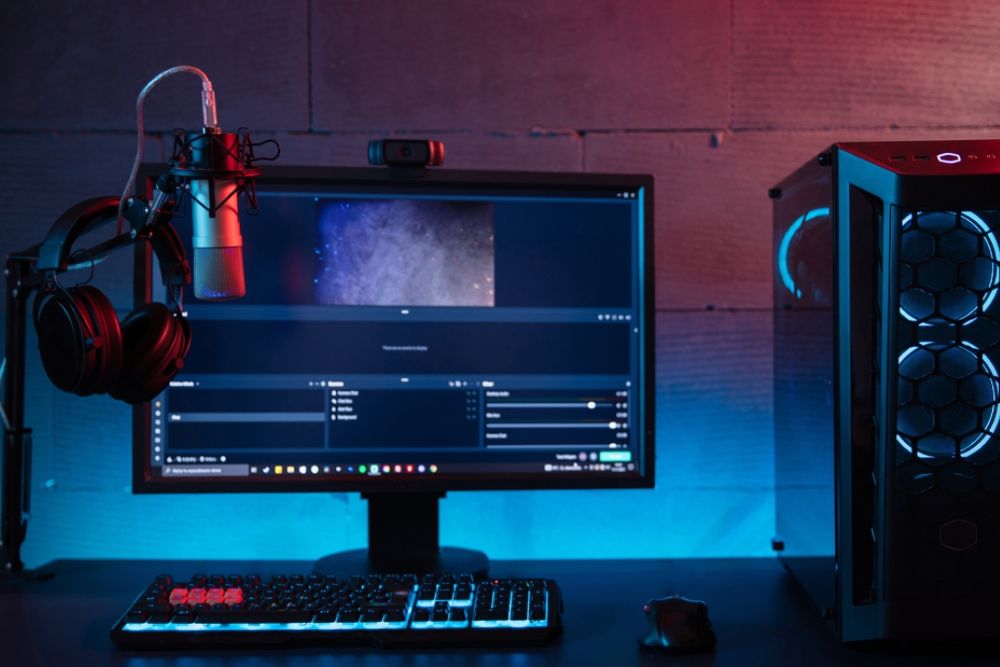When it comes to choosing a display, the debate between gaming monitors and regular screens often comes up. While both options serve the basic purpose of displaying images and videos, they differ in several key areas that can impact your overall experience. Whether you’re an avid gamer or a casual user, understanding these differences can help you decide if a gaming monitor is worth the extra investment or if a standard screen will do the job just fine.
1. Refresh Rate: Smoother Visuals
One of the most significant differences between gaming monitors and regular screens is the refresh rate. The refresh rate, measured in Hertz (Hz), indicates how many times per second the screen updates its image.
- Gaming Monitors: Typically feature high refresh rates ranging from 120 Hz to 360 Hz. This means the screen refreshes more frequently, resulting in smoother motion and less blur during fast-paced action.
- Regular Screens: Usually come with a standard 60 Hz refresh rate, which is adequate for everyday tasks like browsing, watching videos, or office work but may fall short during rapid movements in games.
For gamers, the higher refresh rate means a competitive advantage, as smoother visuals can improve reaction times and overall gameplay. For non-gamers, however, the difference may not be as noticeable.
2. Response Time: Reducing Motion Blur
Response time refers to how quickly a pixel can change from one color to another. Lower response times reduce ghosting and motion blur, which is particularly important in dynamic gaming scenarios.
- Gaming Monitors: Often boast response times as low as 1 ms to 5 ms, ensuring that fast-moving objects on screen appear crisp and clear.
- Regular Screens: Typically have higher response times, around 5 ms to 8 ms or more, which is usually acceptable for standard use but might introduce some blurring during high-speed action.
For gamers, especially those playing competitive titles, a lower response time can enhance clarity and provide a more immersive experience. Casual users, on the other hand, may not notice the subtle differences in motion clarity.
3. Adaptive Sync Technology: Smoother Gameplay
Adaptive sync technologies like NVIDIA’s G-Sync and AMD’s FreeSync are designed to eliminate screen tearing and stuttering by synchronizing the monitor’s refresh rate with the graphics card’s output.
- Gaming Monitors: Frequently include support for these technologies, offering a seamless gaming experience even in fast-paced or graphically intense games.
- Regular Screens: Typically lack advanced adaptive sync features, which can result in occasional tearing or stuttering if the display’s refresh rate doesn’t align with the frame rate output from the computer or console.
For dedicated gamers, adaptive sync is a valuable feature that contributes to a more consistent and fluid visual experience. For everyday use, however, it may be less of a priority.
4. Resolution and Color Accuracy: Beyond Gaming
Both gaming monitors and regular screens come in various resolutions, from Full HD (1080p) to 4K and beyond. While resolution impacts the level of detail you see, color accuracy and image quality are also important factors.
- Gaming Monitors: Many are optimized for high-speed performance, which sometimes means a slight trade-off in color accuracy compared to professional or creative displays. However, many modern gaming monitors are closing that gap by offering vibrant colors and wide color gamuts.
- Regular Screens: Often designed with a focus on color accuracy and image quality, which can be beneficial for photo editing, design work, or media consumption.
If your primary concern is fast-paced gaming, a slight compromise on color accuracy might be acceptable. But if you work with visual media or demand high color fidelity for everyday tasks, a regular screen—or even a specialized professional monitor—might be the better choice.

5. Connectivity and Features
Connectivity options and additional features can also differ between gaming monitors and standard screens.
- Gaming Monitors: Tend to come equipped with multiple ports such as HDMI, DisplayPort, and USB hubs to accommodate a variety of gaming peripherals. Some also offer customizable RGB lighting, on-screen crosshair overlays, or integrated speakers designed for immersive gaming experiences.
- Regular Screens: Focus more on essential connectivity and often feature fewer ports. While many offer USB ports and HDMI connectivity, they might not provide the same level of specialized features found in gaming monitors.
For users who want to build a versatile setup that includes multiple devices and accessories, gaming monitors might offer more flexibility. Casual users may find that standard connectivity options on regular screens suffice.
6. Ergonomics and Design
Ergonomics and overall design can make a significant difference in comfort and usability.
- Gaming Monitors: Often feature adjustable stands with tilt, swivel, and height adjustments to optimize viewing angles during long gaming sessions. They may also have a more aggressive design with bold aesthetics to match a gaming setup.
- Regular Screens: Generally offer simpler designs with basic adjustments. While many provide tilt options, they might not be as versatile in terms of swivel or height adjustments.
If you spend extended hours in front of your screen—whether gaming or working—a monitor with robust ergonomic features can help reduce eye strain and improve comfort.
7. Price Considerations
Price is an important factor when comparing gaming monitors to regular screens.
- Gaming Monitors: Due to their advanced features such as high refresh rates, low response times, and adaptive sync technology, gaming monitors tend to be more expensive. However, the price can vary widely depending on the brand, size, and additional features.
- Regular Screens: Generally more budget-friendly, especially if you don’t require the high-end performance features that gaming monitors offer.
If you’re a casual user whose needs are met by standard performance, opting for a regular screen can be a cost-effective choice. For gamers seeking the best possible performance, the extra investment in a gaming monitor might be justified.
8. Who Should Choose What?
The decision between a gaming monitor and a regular screen ultimately comes down to your individual needs and priorities.
- For Gamers: If you play fast-paced, competitive games where every millisecond counts, a gaming monitor with a high refresh rate, low response time, and adaptive sync technology can significantly enhance your experience. The immersive features and ergonomic designs are tailored to long gaming sessions.
- For Casual Users and Professionals: If your primary activities include web browsing, office work, media consumption, or creative projects, a regular screen that emphasizes color accuracy and image quality might be more suitable. You can save money while still enjoying a high-quality visual experience.
Consider how you use your computer, what types of applications are most important to you, and whether the extra features of a gaming monitor align with your needs.
In the debate between gaming monitors and regular screens, there’s no one-size-fits-all answer. Gaming monitors offer clear advantages for those who demand high performance, smooth motion, and immersive features during intense gaming sessions. On the other hand, regular screens provide excellent image quality and color accuracy for everyday tasks and professional work, often at a more accessible price point.
Ultimately, the choice comes down to your specific requirements and how you plan to use your display. Whether you’re chasing competitive edge in gaming or prioritizing crisp visuals for work and entertainment, understanding the key differences will help you make an informed decision. So, does it really matter? It does—if the features align with your needs.



